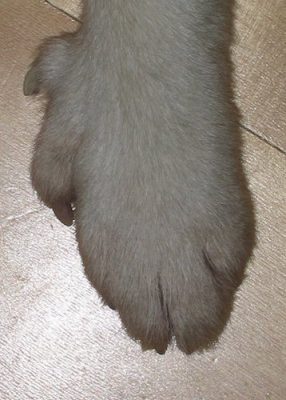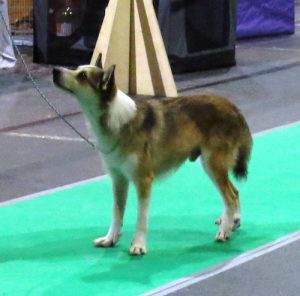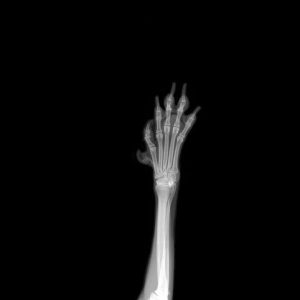
You’ll notice that the dog in the photograph below is standing with his forefeet turned slightly outward, and this is because
his paws are built like the foot in the picture at the left. These same paws give the dog its unique rotary-type front movement when gaiting. He is a Norwegian Lundehund, and the forefeet of this breed are turned slightly outwards to make room for the extra toes present in a polydactyl: Instead of four digits, the Lundehund has six triple-jointed toes and one double-jointed toe. Each toe has well-developed muscles with tendons going up the inside of the leg, and yes indeed, these toes are fully functional. They give a Lundehund better purchase, greater traction, and extra support on steep cliffs and slippery rocks. When hunting Puffins was legal (and as far as we know, only Iceland still allows it), the dog’s extra toes not only acted as brakes, but were also a great help in helping the dog crawl, turn, or shift his position in challenging tunnels and passageways he entered to catch this elusive hole-nesting seabird.
Some Lundehunds may have more than six digits on a foot, and others less, but the AKC breed standard calls for a minimum of six toes on each foot and elongated rear foot pads. It adds that the breed’s feet must be oval with at least six fully developed toes, and five of them should reach the ground. The additional toes consist of one three jointed toe, like a thumb, and one two-jointed toe along with corresponding tendons and muscles that give the foot a strong appearance. Furthermore, in countries where a written critique is given for each dog, the judge is expected to comment on the development and function of those toes.
To see some impressive pictures of Lundehund feet, visit this site.
Images: Lundehund paw by ZorroIII, in 2005 and shared under the terms of the GNU Free Documentation License. X-ray image of a Lundehund foot found on Pinterest and will be happily credited upon receipt of information.


